I NSTANTB USINESS L ETTERS201 letters for every occasionI AIN M AITLAND
To Tracey, Michael and Sophie
Instant Business Letters is written for you the junior, middle or senior manager who has to write letters as part of your job. The first chapter, Writing Effective Letters, sets out all you need to know about planning a letter and choosing the correct approach, layout and style to suit every occasion. It includes a checklist questionnaire which will be of use throughout the book, and beyond. Chapters 2 to 24 contain a wide and diverse range of letters from Acceptances and Acknowledgements through Complaints, Enquiries and Invitations to Thank Yous and Warnings. You can use these immediately or amend them easily for your own, individual circumstances, by referring back to the first chapter and that checklist questionnaire. Whatever your job and type and size of business, trade or industry,
Instant Business Letters is relevant to you.
Study a particular subject by checking the Table of Contents. Dip into it when you wish to find a specific letter by looking through the Letters Index. Read it from cover to cover if you want to learn as much as you can and become a first-class letter writer. Iain Maitland
1
WRITING EFFECTIVE LETTERS
As a businessperson, it is essential that you know how to write effective letters. To begin with, you have to be able to plan a letter and choose the correct appearance, layout and style for each and every occasion.
Planning a Letter
The key to a successful letter is
planning. It is not enough simply to write down whatever comes into your head you need to approach the task in a careful and thorough manner.
Planning a Letter
The key to a successful letter is
planning. It is not enough simply to write down whatever comes into your head you need to approach the task in a careful and thorough manner.
This involves four main steps: 1) identifying your goals 2) establishing the facts 3) analysing the recipient 4) preparing a draft.
Identifying Your Goals
Think about what you are trying to achieve with this letter. Perhaps you wish to introduce your products and services to a prospective customer, and persuade him or her to place an order with your firm. Alternatively, you might want to force a late payer to settle an overdue account as soon as possible, without having to take legal action against that individual or organisation. Whether you are seeking to make a sale, obtain payment or whatever, always have your goals focused clearly in your mind. Your letter should develop from these, and these alone:
Establishing the Facts
Having set your goals, familiarise yourself with the facts of the matter.
To sell those goods and services you must know all about their qualities, prices, special offers, discounts available, delivery dates and the like. If you want to be paid, you have to be conscious of what the invoice relates to, whether the customer has any complaints about it, when it was due for payment, why it has not been paid, and so forth. To ensure that you are totally up to date you will probably need to study your companys records, re-read correspondence, remember telephone calls and perhaps even refer to your professional advisers in some instances.
Analysing the Recipient
You must be certain that the information you wish to put across will be understood by the recipient and not misinterpreted in any way. Otherwise you cannot expect to initiate the desired action, whether a large order or a cheque in settlement of an outstanding account. Consider the person who will receive and read the letter: previous correspondence and telephone conversations should have given you an accurate impression of his or her personality, knowledge and views of the matter.
Put yourself in the readers position, imagining what his or her reaction will be upon opening and studying your letter. Decide what is most likely to generate the required response: for the reader to reach for that order form or cheque-book.
Preparing a Draft
Knowing what you want to achieve, being conscious of the background facts and aware of the recipient, you should be able to jot down the points you wish to make in your initial draft. For example, imagine you have received a letter of complaint about damaged goods delivered to a customer. Your companys policy in such situations is to resolve the complaint as quickly and as fairly as possible, and to maintain the customers goodwill. Six of the 12 products were found to be damaged when their container was opened, and it is most likely that the carrier is to blame as goods are always checked before leaving your warehouse.
The customer wants you to deliver replacement products and collect and credit him for these damaged items as soon as you can. A formal, matter-of-fact approach is taken by the customer in his letter to your company. From this you can note various points for inclusion in your preliminary draft we want to apologise for the problem, we wish to explain why it occurred, we agree to your suggested solution, we have set about resolving the complaint and we want to apologise again. Then sketch out a very rough-and-ready draft, jiggling it into an approximate order but not worrying too much about its appearance, layout or style at the moment. An example of this draft is shown in Letter 1.1.
The Appearance of a Letter
Putting the draft aside for a moment, you now need to consider the appearance of your letter.
This will have a significant impact on the reader and can affect the success or failure of your letter. There are two main areas to think over:
1) envelopes 2) paper.
Envelopes
From the recipients point of view, the envelope you use is his or her first point of contact with you and could also be the last! A cheap and scruffy one with a misspelt name and address scribbled across it is unlikely to impress the reader or put him or her in a favourable mood towards the letter within it. Choose quality envelopes, which help to convey a professional and dignified image of your firm. White or other conservative colours can develop this impression and also stand out from the nondescript buff envelopes used so often by run-of-the-mill businesses. Carefully put the recipients name, job title (if appropriate), address and postcode in the centre of the front of the envelope, making sure they are identical to those on the letter itself. If you make an error, always start again with a fresh envelope writing over or crossing out a mistake looks careless.
Should you have a rubberstamp of your firms name and/or logo, imprint it at the top left. Neatly place a stamp in the top right-hand corner.
Paper
You should select watermarked, A4-sized paper (or 8 x 11 inches for U.S. businesspeople) for your letters ideally it will match the envelopes so that a neat and unified image is put across. Half-sized A5 paper (U.S. equivalent would be 4 X 6 inches) can be used for shorter letters such as acknowledgements, assuming that you have smaller envelopes as well.
It is important that the paper and envelope fit together properly, maintaining that complementary and coordinated impression. You will have to use common sense to decide whether to type or write the letter by hand. A typed letter is more formal and professional in appearance, whereas a handwritten one is more personal, which may be appropriate on some occasions, such as when you have to apologise, offer condolences or thank someone. Whatever your choice, letters must be neat and easy to read. Tidy, error-free text is essential, as are paragraphs of similar size and generous margins at the top, sides and bottom.

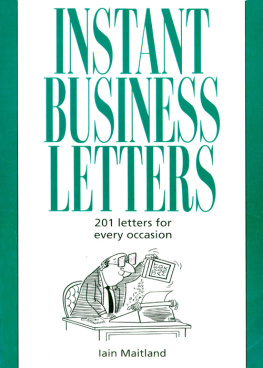
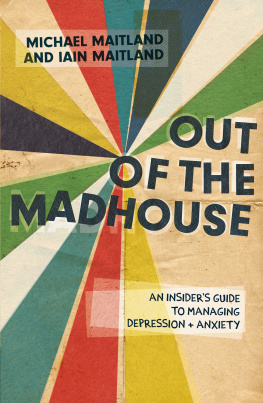

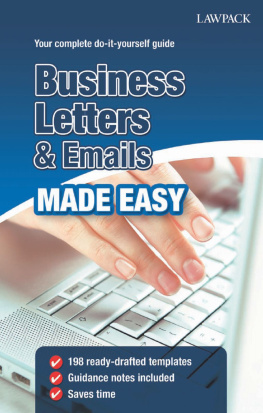
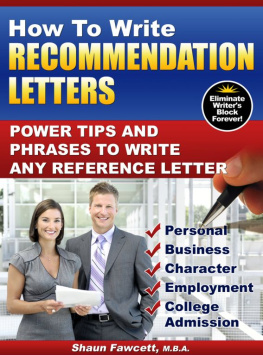

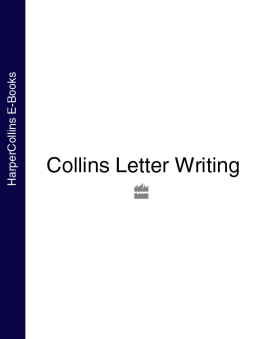
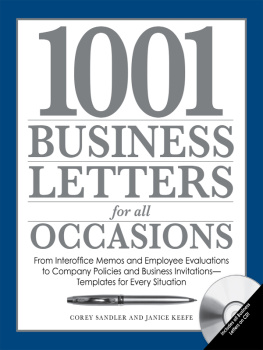
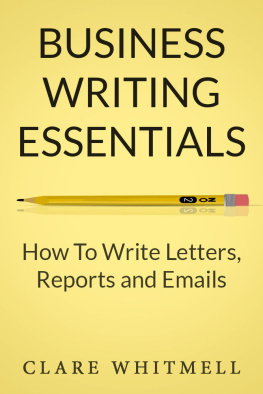

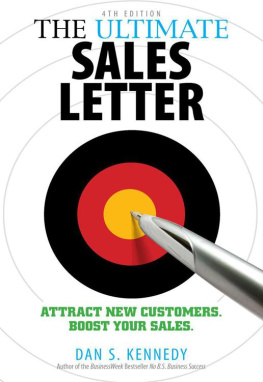
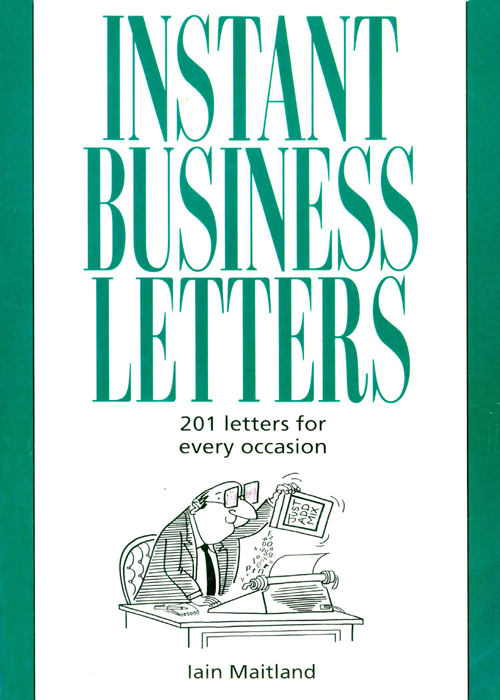
 To Tracey, Michael and Sophie Instant Business Letters is written for you the junior, middle or senior manager who has to write letters as part of your job. The first chapter, Writing Effective Letters, sets out all you need to know about planning a letter and choosing the correct approach, layout and style to suit every occasion. It includes a checklist questionnaire which will be of use throughout the book, and beyond. Chapters 2 to 24 contain a wide and diverse range of letters from Acceptances and Acknowledgements through Complaints, Enquiries and Invitations to Thank Yous and Warnings. You can use these immediately or amend them easily for your own, individual circumstances, by referring back to the first chapter and that checklist questionnaire. Whatever your job and type and size of business, trade or industry, Instant Business Letters is relevant to you.
To Tracey, Michael and Sophie Instant Business Letters is written for you the junior, middle or senior manager who has to write letters as part of your job. The first chapter, Writing Effective Letters, sets out all you need to know about planning a letter and choosing the correct approach, layout and style to suit every occasion. It includes a checklist questionnaire which will be of use throughout the book, and beyond. Chapters 2 to 24 contain a wide and diverse range of letters from Acceptances and Acknowledgements through Complaints, Enquiries and Invitations to Thank Yous and Warnings. You can use these immediately or amend them easily for your own, individual circumstances, by referring back to the first chapter and that checklist questionnaire. Whatever your job and type and size of business, trade or industry, Instant Business Letters is relevant to you.